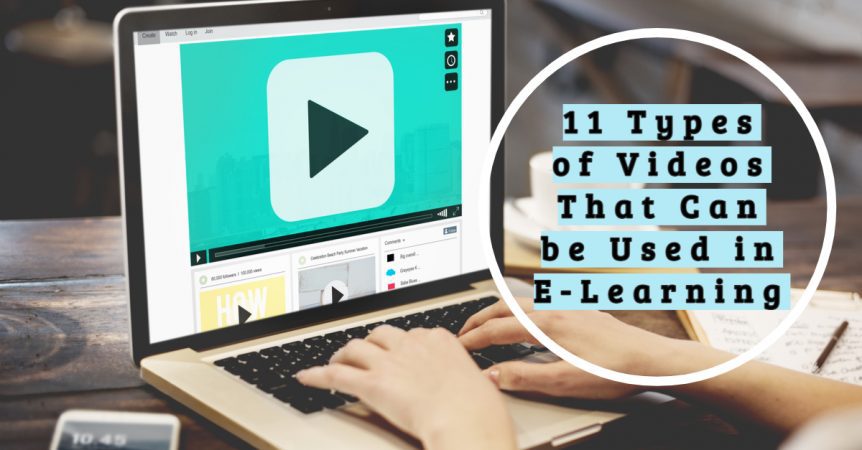11 Types of Videos That Can be Used in E-Learning
Videos are a core component of many e-learning training courses. In fact, in some cases, the video is the training course. Not all videos are the same, however, and there are multiple types and styles that are available.
Using a variety of video types can enhance your e-learning courses and keep learners engaged.
Presentation Video
Presentation videos can take a range of forms, but one of the most common is where a trainer or subject matter expert goes through a PowerPoint presentation or a similar presentation tool. Whiteboard tools can also be used.
Presentation videos involve recording the screen with an inset video of the presenter. It is an effective method to use in a range of situations, not least because it is a familiar type of video for people in the UAE and Saudi Arabia.
Demonstration and How-To Videos
Demonstration videos are where the subject matter expert or trainer goes through the steps of performing a task, explaining as they go. They are suitable for everything from demonstrating how to use a new software application to repairing a machine to using a piece of equipment.
Piece to Camera Video (Talking Head Video)
Piece to camera videos are similar to presentation videos, except there is no presentation. Instead of the presentation, the trainer or subject matter expert speaks directly to the learner to explain a concept or topic.
This is another type of video that will be very familiar to learners and is particularly suitable when the person presenting has name recognition.
Animation
Animated videos can be less costly to produce, they can explain complex topics, or they can do both. They offer a wide range of options for e-learning course developers to create content that will not only engage learners and enhance the learning experience, but also facilitate the learning process.
Interview Videos
Interview videos involve two or more people, with one person asking questions and another answering. They are a type of video that is only suitable in specific situations, but they can be highly effective.
The situations where they are effective include where the content includes viewpoints from employees, customers, or partners, or where a conversational style is the best way to get across the information. For example, an employee explaining their experience of the onboarding process as part of an onboarding e-learning course.
Introduction and Teaser Videos
Introduction and teaser videos can be used in situations where you think it will be beneficial to promote the course to encourage your team to complete it. This type of video is usually used on courses that are optional and/or where you want to identify individuals with a passion or ambition in a particular area.
Teaser videos can take a range of forms. The typical objective is to explain what learners can expect from the course.
Interactive Videos
Most video content in e-learning courses is passive, i.e., the learner watches the video and is not really required to do anything else. Interactive videos are different as they involve the learner getting involved. Often, this is to make a decision or answer a question. They are a type of video that can further enhance engagement levels and create new learning experiences.
Webinar
A webinar is similar to a presentation video, as it typically involves a trainer or subject matter expert going through a presentation. The main difference is that a webinar is recorded during a live and interactive training session where there are participants. Those participants can often ask questions and get involved in other ways.
In some circumstances, watching a recorded webinar and the interactions it contains can offer added benefits to learners.
Whiteboard Animation Videos
A whiteboard animation video is a type of animation where the images and text appear on the screen as if being drawn onto a whiteboard. They are ideal for storytelling and explaining scenarios, so they can be used to make the training more relevant to the learner.
The whiteboard animation style differentiates this type of video from standard animations, enhancing the overall experience for learners.
Kinetic Typography Videos
Kinetic typography videos are another style of animation that offers something different from standard animation. They feature moving text on the screen and are often colourful and expressive. They can also include narration to add greater depth to the words and figures being displayed on the screen.
Kinetic typography videos can be good for presenting facts and figures, so they can be an alternative to a static infographic or image.
Micro Videos
Micro videos are more about the length of the video rather than the style or approach taken in production. Typically, micro videos are about a minute long, but they can be even less. The idea is to explain a single topic or concept without distraction and as concisely as possible.
Micro videos can be effective in a range of situations, including when you are using a microlearning strategy for the development of your e-learning course.
Quality Over Quantity
Whatever type of video you decide to include in your e-learning course, quality is the most important aspect. The people completing your course will have high expectations when watching a video you produce, so always go for quality rather than quantity. Variety in e-learning (and in all training materials) is helpful too.
